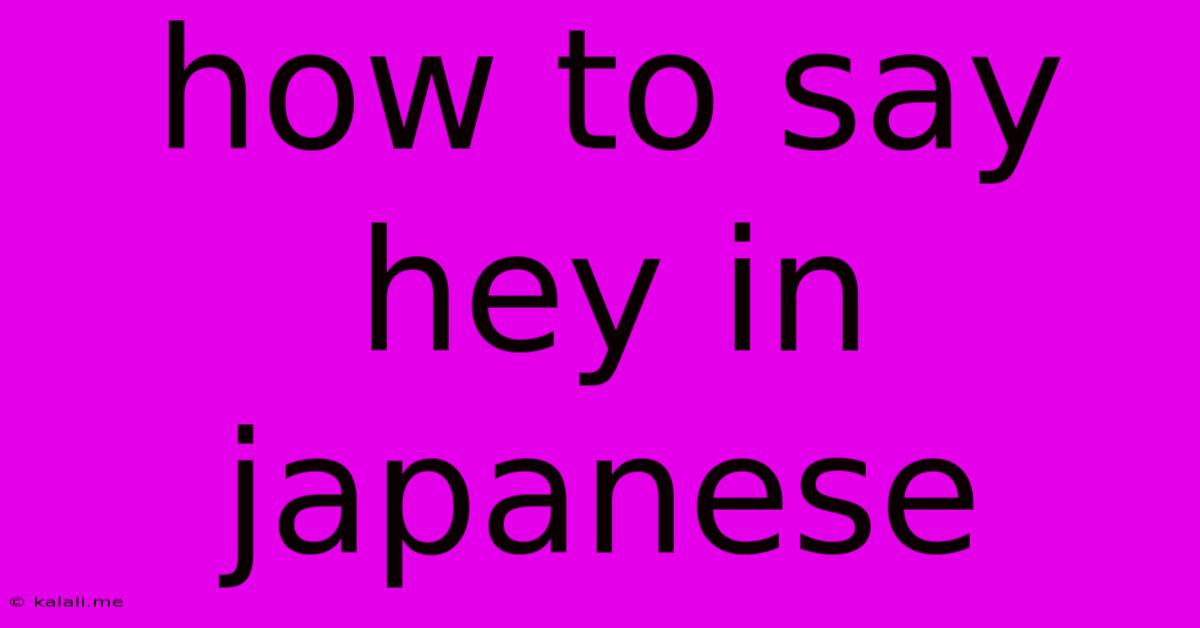How To Say Hey In Japanese
Kalali
May 24, 2025 · 3 min read

Table of Contents
How to Say "Hey" in Japanese: A Comprehensive Guide
Knowing how to greet someone is crucial when learning a new language, and Japanese is no exception. While there isn't a single perfect equivalent to the English "hey," there are many ways to say "hey" in Japanese, each with its own nuance and level of formality. This guide will explore various options, helping you choose the most appropriate greeting for any situation. This includes looking at different situations, levels of formality, and the cultural context surrounding greetings in Japan.
Choosing the right greeting depends on several factors: your relationship with the person you're addressing (friend, colleague, superior, stranger), the setting (formal meeting, casual hangout), and the time of day. Let's dive into the options.
Casual Greetings: Perfect for Friends and Family
For informal situations with close friends and family, several options work well, reflecting the relaxed and friendly nature of your relationship.
-
おい (Oi): This is a very casual and somewhat blunt way to get someone's attention. Think of it as a more forceful "hey" or "yo." Use it with caution, primarily among close friends, and avoid using it with elders or superiors.
-
ねえ (Nee): This translates roughly to "hey" or "listen." It's a softer, gentler way to get someone's attention compared to "Oi." It's suitable for friends and family but generally avoided in formal settings.
-
やあ (Yaa): A more upbeat and friendly "hi" or "hey," suitable for close friends and casual acquaintances. It has a slightly more cheerful connotation than "Nee."
-
よお (Yō): Similar to "Yaa," but slightly rougher around the edges. Consider the context and your relationship before using this one.
Formal Greetings: Respectful Approaches for Professional and Social Settings
When interacting with people you don't know well, superiors, or in formal situations, you need to be more respectful in your greetings.
-
こんにちは (Konnichiwa): This is the most common and versatile greeting, meaning "hello" or "good afternoon." It's appropriate for almost any situation and is a safe bet if you're unsure which greeting to use.
-
おはようございます (Ohayou gozaimasu): This means "good morning" and is used from sunrise until roughly noon. It's a polite and respectful greeting.
-
こんばんは (Konbanwa): This means "good evening" and is used from evening until you go to bed. Another polite and widely accepted greeting.
Beyond the Basics: Adding Nuance to Your Greetings
The context plays a vital role. Consider these points:
-
Time of Day: Using the appropriate greeting for the time of day shows consideration and politeness.
-
Relationship: Avoid using casual greetings with strangers or superiors. Respectful formality goes a long way in Japanese culture.
-
Tone of Voice: Even the most polite greeting can sound rude if delivered with the wrong tone. Try to maintain a respectful and friendly tone.
Mastering the Art of Japanese Greetings
Learning how to say "hey" in Japanese isn't just about memorizing words; it's about understanding the cultural nuances and choosing the most appropriate greeting for each situation. By paying attention to context, relationship, and tone, you can communicate effectively and respectfully, making a positive impression on those you interact with. Practice using these phrases in different scenarios, and you'll soon feel confident using them naturally. Remember to listen to native speakers and try to mimic their intonation and pronunciation for the most authentic experience. Good luck!
Latest Posts
Latest Posts
-
Camera Based On Quaternion In C Opengl
May 24, 2025
-
O T T F F S S Riddle
May 24, 2025
-
Etc Ssh Sshd Config Line 125 Deprecated Option Rsaauthentication
May 24, 2025
-
Explain The Ending Of A Most Wanted Man
May 24, 2025
-
Animal Crossing City Folk Face Guide
May 24, 2025
Related Post
Thank you for visiting our website which covers about How To Say Hey In Japanese . We hope the information provided has been useful to you. Feel free to contact us if you have any questions or need further assistance. See you next time and don't miss to bookmark.